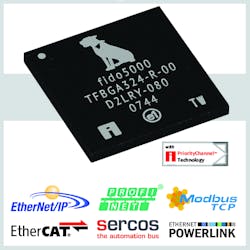Though the industrial world has largely adopted Ethernet as its mainstay networking technology, equipment suppliers use many different flavors of Ethernet. In most facilities, network managers have to connect to front office systems while also communicating with a range of Ethernet protocols used by disparate equipment on the plant floor.
Ethernet cables are being used by manufacturers in every industry and geography for automation, video, business systems, mobility, collaboration and security. But differences in protocols are forcing network manager to deal with multiple protocols.
“The key distinction to point out here is understanding that not all protocols that are Ethernet-based are fully standardized at all layers of the OSI model, which means they cannot be readily integrated into a single-network infrastructure,” says Paul Brooks, a Rockwell Automation manager representing the Industrial IP Advantage. “The value at stake with the Internet of Things transformation in connecting people, process, plants and things means an explosion in fully standards-compliant communications protocol traffic.”
On the plant floor, different requirements have been met by using variations of Ethernet. Cabling and connectors are universal, but end users will have to convert information from differing versions of Ethernet.
“Multi-protocol support is a must for the industry,” says Tom Weingartner, marketing vice president at Innovasic. “You can’t have only one protocol unless you’ve only got equipment from one supplier, and not too many people have that.”
Equipment suppliers must determine how many of these Ethernet derivatives they want to support. As with all technologies, providing customer support is an important factor in corporate strategies.
“Companies would have to be crazy not to offer multi-protocol support, with at least some support for non-preferred networks,” says Carl Henning, deputy director of PI North America. “They probably won’t cover every network; you get to a point of diminishing returns if you try to cover everything.”
End users will also have to decide how many of these networks they want to employ. Technicians on the plant floor can’t be expected to understand all the subtleties of several different networking schemes.
“The key challenges to supporting more than one protocol are to understand the different protocols, set them up, and troubleshoot them,” says Joaquin Ocampo, product manager at Bosch Rexroth. “This entails different software and hardware to accomplish the tasks. Since it is Ethernet, the channel or cable is now the same. This at least is a common factor in the different Ethernet protocols.”
Component suppliers are working to help equipment makers more easily handle disparate communications. As with cabling, ensuring that no special hardware is needed to enable communications between multiple versions of Ethernet is critical. “We provide driver support for switches so they can communicate at the API level,” Weingartner says. “That makes it easier to implement a stack. The drivers configure the network for each protocol. People can create a true switch that supports all protocols. They can also be tailored to support Profinet or any other protocol, any stack or any processors. EtherCAT, for example, doesn’t require a switch, but our switches can be tailored to be EtherCAT slaves.”
Multi-protocol support is becoming increasingly common, making it simpler for integrators and network managers to link equipment from various suppliers. This trend is expected to continue to enhance ease of use.
“In the Sercos protocol, three protocols can be used in the same channel,” Ocampo says. “Single-wire connectivity offers the user the freedom to use Sercos, TCP/IP and EtherNet/IP with one Ethernet wire. This way the user can have different devices without the need to have a separate wire for each type of device, reducing the need for additional hardware to control the devices of the different protocol.”

